Input interpretation

1-ethyl-2, 3-dimethylimidazolium methyl carbonate
Basic properties
![molar mass | 200.2 g/mol formula | C_9H_16N_2O_3 empirical formula | C_9O_3N_2H_16 SMILES identifier | CC[N+]1=C(C)N(C)C=C1.COC(=O)[O-] InChI identifier | InChI=1/C7H13N2.C2H4O3/c1-4-9-6-5-8(3)7(9)2;1-5-2(3)4/h5-6H, 4H2, 1-3H3;1H3, (H, 3, 4)/q+1;/p-1/fC7H13N2.C2H3O3/qm;-1 InChI key | FAFIVIBGDSQQSG-UHFFFAOYSA-M](../image_source/e958207d9a86b16e4f1a778a59fc64c3.png)
molar mass | 200.2 g/mol formula | C_9H_16N_2O_3 empirical formula | C_9O_3N_2H_16 SMILES identifier | CC[N+]1=C(C)N(C)C=C1.COC(=O)[O-] InChI identifier | InChI=1/C7H13N2.C2H4O3/c1-4-9-6-5-8(3)7(9)2;1-5-2(3)4/h5-6H, 4H2, 1-3H3;1H3, (H, 3, 4)/q+1;/p-1/fC7H13N2.C2H3O3/qm;-1 InChI key | FAFIVIBGDSQQSG-UHFFFAOYSA-M
Structure diagram
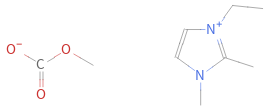
Structure diagram
Quantitative molecular descriptors
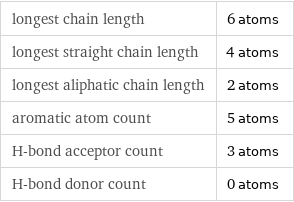
longest chain length | 6 atoms longest straight chain length | 4 atoms longest aliphatic chain length | 2 atoms aromatic atom count | 5 atoms H-bond acceptor count | 3 atoms H-bond donor count | 0 atoms
Elemental composition

Find the elemental composition for 1-ethyl-2, 3-dimethylimidazolium methyl carbonate in terms of the atom and mass percents: atom percent = N_i/N_atoms × 100% mass percent = (N_im_i)/m × 100% Plan: • Write the chemical formula and gather atomic masses from the periodic table. • Determine values for N_i, m_i, N_atoms and m using these items. • Finally, compute the percents and check the results. Write the chemical formula: C_9H_16N_2O_3 Use the chemical formula to count the number of atoms, N_i, for each element and find the total number of atoms, N_atoms, per molecule: | number of atoms C (carbon) | 9 O (oxygen) | 3 N (nitrogen) | 2 H (hydrogen) | 16 N_atoms = 9 + 3 + 2 + 16 = 30 Divide each N_i by N_atoms to calculate atom fractions. Then use the property that atom fractions must sum to one to check the work: | number of atoms | atom fraction C (carbon) | 9 | 9/30 O (oxygen) | 3 | 3/30 N (nitrogen) | 2 | 2/30 H (hydrogen) | 16 | 16/30 Check: 9/30 + 3/30 + 2/30 + 16/30 = 1 Compute atom percents using the atom fractions: | number of atoms | atom percent C (carbon) | 9 | 9/30 × 100% = 30.0% O (oxygen) | 3 | 3/30 × 100% = 10.00% N (nitrogen) | 2 | 2/30 × 100% = 6.67% H (hydrogen) | 16 | 16/30 × 100% = 53.3% Look up the atomic mass, m_i, in unified atomic mass units, u, for each element in the periodic table: | number of atoms | atom percent | atomic mass/u C (carbon) | 9 | 30.0% | 12.011 O (oxygen) | 3 | 10.00% | 15.999 N (nitrogen) | 2 | 6.67% | 14.007 H (hydrogen) | 16 | 53.3% | 1.008 Multiply N_i by m_i to compute the mass for each element. Then sum those values to compute the molecular mass, m: | number of atoms | atom percent | atomic mass/u | mass/u C (carbon) | 9 | 30.0% | 12.011 | 9 × 12.011 = 108.099 O (oxygen) | 3 | 10.00% | 15.999 | 3 × 15.999 = 47.997 N (nitrogen) | 2 | 6.67% | 14.007 | 2 × 14.007 = 28.014 H (hydrogen) | 16 | 53.3% | 1.008 | 16 × 1.008 = 16.128 m = 108.099 u + 47.997 u + 28.014 u + 16.128 u = 200.238 u Divide the mass for each element by m to calculate mass fractions. Then use the property that mass fractions must sum to one to check the work: | number of atoms | atom percent | mass fraction C (carbon) | 9 | 30.0% | 108.099/200.238 O (oxygen) | 3 | 10.00% | 47.997/200.238 N (nitrogen) | 2 | 6.67% | 28.014/200.238 H (hydrogen) | 16 | 53.3% | 16.128/200.238 Check: 108.099/200.238 + 47.997/200.238 + 28.014/200.238 + 16.128/200.238 = 1 Compute mass percents using the mass fractions: Answer: | | | number of atoms | atom percent | mass percent C (carbon) | 9 | 30.0% | 108.099/200.238 × 100% = 53.99% O (oxygen) | 3 | 10.00% | 47.997/200.238 × 100% = 23.97% N (nitrogen) | 2 | 6.67% | 28.014/200.238 × 100% = 13.99% H (hydrogen) | 16 | 53.3% | 16.128/200.238 × 100% = 8.054%
Elemental oxidation states

The first step in finding the oxidation states (or oxidation numbers) in 1-ethyl-2, 3-dimethylimidazolium methyl carbonate is to draw the structure diagram. Next set every oxidation number equal to the atom's formal charge: In 1-ethyl-2, 3-dimethylimidazolium methyl carbonate hydrogen is not bonded to a metal with lower electronegativity, so it will have an oxidation state of +1. Any element bonded to hydrogen gains the bonding electrons, decreasing their oxidation state by 1 for every bond: With hydrogen out of the way, look at the remaining bonds. There are 6 carbon-nitrogen bonds, 4 carbon-oxygen bonds, and 3 carbon-carbon bonds. For each of these bonds, assign the bonding electrons to the most electronegative element. First examine the carbon-nitrogen bonds: element | electronegativity (Pauling scale) | C | 2.55 | N | 3.04 | | | Since nitrogen is more electronegative than carbon, the electrons in these bonds will go to nitrogen. Decrease the oxidation number for nitrogen in every highlighted bond (by 1 for single bonds, 2 for double bonds, and 3 for triple bonds), and increase the oxidation number for carbon accordingly: Next look at the carbon-oxygen bonds: element | electronegativity (Pauling scale) | C | 2.55 | O | 3.44 | | | Since oxygen is more electronegative than carbon, the electrons in these bonds will go to oxygen: Next look at the carbon-carbon bonds: element | electronegativity (Pauling scale) | C | 2.55 | C | 2.55 | | | Since these elements are the same the bonding electrons are shared equally, and there is no change to the oxidation states: Now summarize the results: Answer: | | oxidation state | element | count -3 | C (carbon) | 2 | N (nitrogen) | 2 -2 | C (carbon) | 2 | O (oxygen) | 3 -1 | C (carbon) | 1 0 | C (carbon) | 2 +1 | H (hydrogen) | 16 +3 | C (carbon) | 1 +4 | C (carbon) | 1
Orbital hybridization
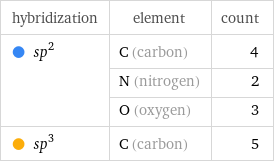
hybridization | element | count sp^2 | C (carbon) | 4 | N (nitrogen) | 2 | O (oxygen) | 3 sp^3 | C (carbon) | 5
Structure diagram
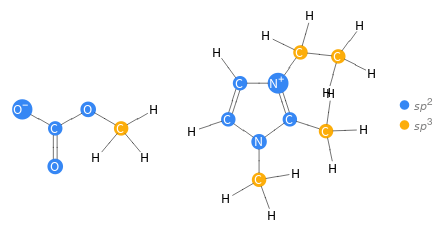
Orbital hybridization Structure diagram
Topological indices
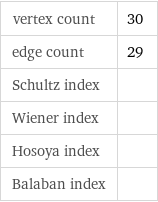
vertex count | 30 edge count | 29 Schultz index | Wiener index | Hosoya index | Balaban index |